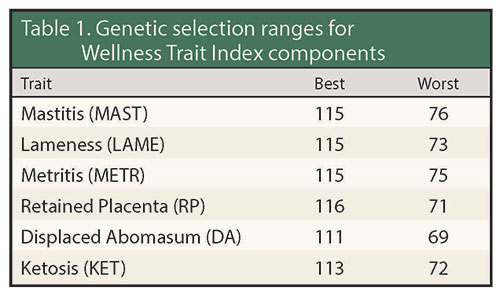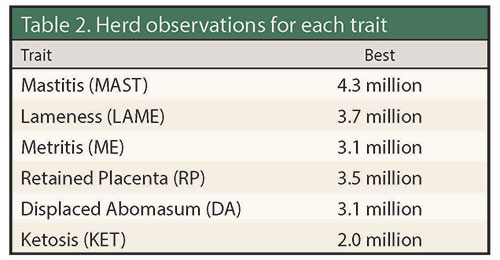
Genomics has allowed us to learn a great deal about a calf immediately after birth. The amount of information we can glean from one DNA sample has grown greatly compared to just a generation ago via traditional genetic evaluation systems.
This April a whole new era in genetic evaluations will be written after Zoetis released a new genomic test that now includes additional economically-relevant health traits. That new information will give every Holstein breeder the ability to select healthier cows through genetic selection on six traits: mastitis, lameness, metritis, displaced abomasum, retained placenta and ketosis.
Three new tools in the cabinet
While the six new wellness traits represent the latest genetic innovation available to farmers, there are three ways to incorporate the collective package on the farm: Clarifide Plus, Dairy Wellness Profit (DWP$) index and Wellness Traits index (WT$).
Dairy producers can obtain genomic predictions on these six health traits by using the newly released Clarifide Plus test. Likewise, everyone making mating decisions has two new selection tools at their disposal. The six health traits have their very own index officially called the Wellness Traits index or WT$.
While the health component is crucial, dairy farmers should focus on breeding a complete cow. That is why the six health traits also have been rolled into the Dairy Wellness Profit or DWP$. This complete breeding index leverages components of the well-known Net Merit index (NM$) and again includes the six new health traits found in the WT$.
Up until now, the sheer amount of data required to fuel the genetic development of genetic predictions for many health traits has been a limiting factor. Overcoming that obstacle, Zoetis worked with “north of 200 large dairies,” as Doug Ricke, who manages global strategic marketing Zoetis, put it, “to collect some 10 million lactation records and almost double that in total health events that directly link on-farm observations with genomic outcomes.”
To fuel the system, Zoetis worked with the farms to connect genomic profiles with health events from herd management software computers. All this was done with the owner’s permission. These herds, along with Zoetis research and development assets, included more than 105,000 genotypes representing some 15.6 million pedigrees in this initiative.
Why focus on these six traits?
“These traits cost the industry billions of dollars,” said Mike Lormore, a veterinarian with Zoetis. “That’s “B” as in billions.”
Selection will pay dividends
“Wellness is now a profitable choice for dairy producers,” said Cheryl Marti, who leads U.S. dairy genetic marketing efforts with Zoetis. “By selecting for these traits, dairy producers are increasing the odds of making the right heifer selection decision,” she said in discussing the newfound ability to select future herd replacements that have the ability to remain healthy. “It takes a great deal of energy in the form of labor, feed and other financial resources to raise a heifer.”
“It’s not really until the second lactation that cows exceed the rearing costs and provide a positive return on that investment,” explained Dan Weigel, a geneticist with Zoetis who noted mature cows give 25 percent more milk than younger herdmates. “Those cows that can stay in the herd quietly, and for a long time, are the most profitable,” he went on to say, noting that everyone milking cows for a living wants more of those individuals.
While the dairy cattle breeding community and dairy farmers have made some progress on a few health traits, it’s been somewhat slow going. Until recently, the industry could select for reduced mastitis via predicted transmitting ability somatic cell score (PTA SCS), improved fertility by looking at daughter pregnancy rate (PTA DPR), and overall health by choosing animals with higher productive life (PTA PL) scores. The new effort led by Zoetis takes health trait selection to an entirely new stratosphere.
As for the economic cost linked to each of these six health events, the team utilized USDA values along with peer-reviewed articles to generate economic factors in the index development. Therefore, Dairy Wellness Profitability or DWP$ gives greater focus to the most costly health events. DWP$ does this by placing 30 percent emphasis on the wellness traits or WT$. The remainder of the DWP$ includes: production, 34 percent; health and calving, 19 percent; type, 10 percent; and fertility, 7 percent.
Mastitis is the most costly disease dairy farmers deal with and lameness stands a close second. That’s why mastitis (MAST) accounts for 41 percent of the index weighting and lameness (LAME) garners 27 percent. Those two health events, along with metritis (METR) at 19 percent, account for 87 percent of the wellness focus.
Three other traits round out the WT$ index: displaced abomasum (DA), 6 percent; retained placenta (RP), 6 percent; and ketosis (KET), 1 percent. While ketosis has health-related ramifications, the genetic correlation just up to this point was not as strong as the other traits.
“In general, we ignored health traits far too long,” said Weigel. “Based on efforts with our customers, we know that the bottom 10 percent of heifers based on NM$ cannot make it through the second lactation. Why even raise them?”
To help position the proper usage of the six traits, Zoetis chose to present the traits similar to those found in Canada and Europe.
“We wanted to avoid negative numbers,” said David Erf, geneticist with the animal health company. “There just seems to be a stigma associated with negative numbers.”
For example, the average male or female for mastitis would rank at 100. The best Holstein would be near 115 while the worst would be around 76. That means a cow or bull with a 115 for mastitis has a lower expected risk of the disease. The ranges for all traits are shown in Table 1.

These six wellness traits have a 49 to 51 percent reliability in young females compared to no existing information without a genomic test. Remember, every trait averages 100. This is a result of gathering millions of health event records shown in Table 2. These events served as the foundation for genomic predictions for each of the wellness traits.

Just like the evaluations conducted by the Council on Dairy Cattle Breeding (CDCB), values for the six traits will be updated three times per year. Also, the genetic base for these traits will change every five years, the same as CDCB evaluations.
To evaluate bovines
To obtain genomic test results on these Wellness Traits (WT$) for individuals in your herd, dairy producers should use the new Clarifide Plus test. Not only does that test include the six new health traits, it also has polled or hornless status determination. The test will also continue to access CDCB core production, health and reproductive outcomes as well as fertility haplotypes.
The study of genomics has made tremendous inroads as 7 to 8 percent of the nation’s Holsteins now have a genomic profile. That makes the dairy breed the most investigated group of bovines on the planet.
“Well-managed herds will see the most success,” explained Weigel. “When using DWP$ as a selection tool for females, there can be a $1,200 lifetime profitability difference or more based on genetics between the top 10 percentile and bottom 10 percentile of ranked animals in average management herds. For the very familiar Net Merit Index, that spread is closer to $990 because it doesn’t directly account for differences in health outcomes.”
“Finally, seeing this research get to the point of being an available tool that producers can use for making genetic selection decisions to raise animals with reduced risk for health problems is really encouraging,” said Kent Weigel, geneticist and chair of the dairy science department at University of Wisconsin-Madison. “When you have traits that have an emphasis on health, longevity and wellness all integrated into one package, this allows producers to make decisions earlier and invest in raising healthy animals. Healthier cows stay in the herd longer and make an enormous difference in a herd’s profitability,” said the Wisconsin geneticist.








